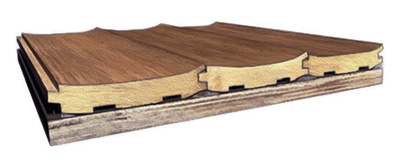What is a cupping floor?
Wood is a living material which is continually reacting with its environment, even after its transformation. Depending on the species and width, wood will expand or shrink when exposed to humidity.
If the humidity level is high, a hardwood floor will expand and the space between boards will not be sufficient. The board’s edges will then bend upwards, and a depression will form at the centre. The boards will have a concave aspect, commonly named “cupping.”
Necessary precautions must be taken all year long to prevent your floor from expanding or shrinking.
Main reasons why my floor is cupping
• Too high humidity level of the ambient air
• Too high humidity level of the subfloor
• Not enough time for the wood to acclimatize before installation
• Water ingress
• Poorly maintained floor

What to do for a stable floor:
BEFORE INSTALLATION
• A week before installation, the room’s temperature must be between 18 and 22 °C (65 and 72 °F) and the humidity level between 37 and 45%.
• Cartons must be placed in the premises 48 hours before the installation. Do not stack more than three boxes and let spaces between stacks to let the air flow.
INSTALLATION DAY
• First, make sure that the room’s temperature is between 18 and 22 °C and the humidity level is between 37 and 45%.
• Make sure that the subfloor’s humidity is below 12% and the flooring itself is between 6 and 8%.
• An expansion joint of ¾ in (0.78 mm) must be left alongside the walls. This will allow the floor to expand. Nevertheless, if humidity is too high, this joint might not be enough to prevent your floor from getting a concave shape.
ON A DAILY BASIS
• The premises must be kept between 18 and 22 °C with a humidity level between 37 and 45% ALL YEAR LONG.
• To maintain your floor, only use cleaning products especially designed for hardwood floors. Never use water. To maintain your floor, only use cleaning products especially designed for hardwood floors. Never use water.
• Always wipe immediately any liquid spill on the floor before it is absorbed by wood fibres.
IN CASE OF WATER INGRESS
• Stop the leak and mop everything.
• Contact a specialist.
*Please note that a dehumidifier or a fan is not enough to dry your floor completely and won’t prevent cupping.

